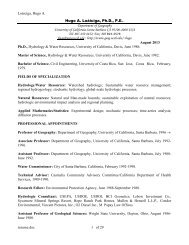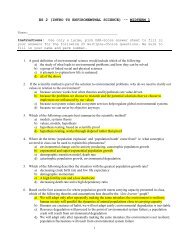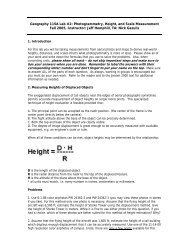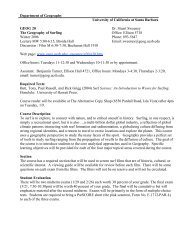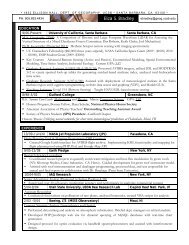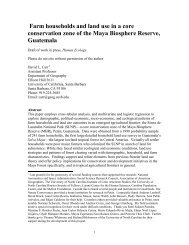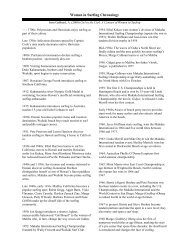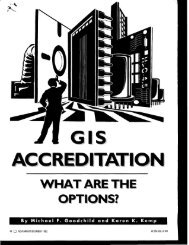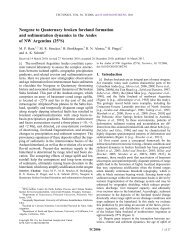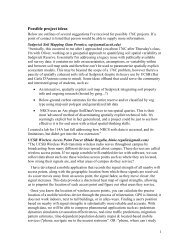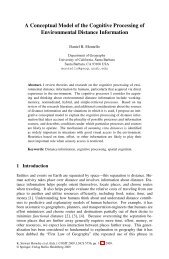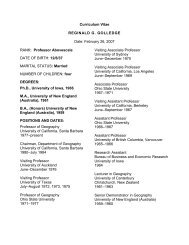Spatial knowledge acquisition from direct experience in the ...
Spatial knowledge acquisition from direct experience in the ...
Spatial knowledge acquisition from direct experience in the ...
You also want an ePaper? Increase the reach of your titles
YUMPU automatically turns print PDFs into web optimized ePapers that Google loves.
94 T. Ishikawa, D.R. Montello / Cognitive Psychology 52 (2006) 93–129<br />
Keywords: <strong>Spatial</strong> <strong>knowledge</strong>; <strong>Spatial</strong> microgenesis; Cognitive maps; Large-scale spaces; Individual diVerences<br />
1. Introduction<br />
As people act <strong>in</strong> <strong>the</strong> environment, <strong>the</strong>y perceive surround<strong>in</strong>g space and acquire <strong>knowledge</strong><br />
about it. Downs and Stea (1973) called this fundamental process cognitive mapp<strong>in</strong>g.<br />
Knowledge acquired dur<strong>in</strong>g cognitive mapp<strong>in</strong>g <strong>in</strong>cludes <strong>the</strong> identities of places and landmarks,<br />
<strong>the</strong> patterns of path connections between places, distances, and <strong>direct</strong>ions between<br />
places, and so on. People use spatial <strong>knowledge</strong> of <strong>the</strong> environment to get to dest<strong>in</strong>ations<br />
such as home and work, to give and <strong>in</strong>terpret navigational <strong>in</strong>structions, to <strong>in</strong>terpret maps,<br />
to plan eYcient trips, and more. These k<strong>in</strong>ds of <strong>knowledge</strong> help guide people’s actions <strong>in</strong><br />
adaptive ways, <strong>in</strong> o<strong>the</strong>r words, so that <strong>the</strong>ir behavior is coord<strong>in</strong>ated not only to <strong>the</strong> environment<br />
as perceived but also to <strong>the</strong> environment as conceived and remembered. Many<br />
researchers <strong>from</strong> various discipl<strong>in</strong>es have <strong>in</strong>vestigated human spatial <strong>knowledge</strong> of environments,<br />
particularly s<strong>in</strong>ce <strong>the</strong> late 1960s (see Cox & Golledge, 1969; Evans, 1980; Liben,<br />
Patterson, & Newcombe, 1981; Lynch, 1960).<br />
A major research question that has attracted much <strong>the</strong>oretical <strong>in</strong>terest concerns <strong>the</strong><br />
structure of spatial <strong>knowledge</strong> about environments and <strong>the</strong> process of spatial <strong>knowledge</strong><br />
<strong>acquisition</strong> <strong>in</strong> new environments. As Ittelson (1973) discussed, <strong>the</strong> environment is larger<br />
than and surrounds <strong>the</strong> human body, so that a person cannot grasp <strong>the</strong> layout of <strong>the</strong> environment<br />
<strong>in</strong> its entirety <strong>from</strong> a s<strong>in</strong>gle viewpo<strong>in</strong>t. Instead, one must locomote about <strong>the</strong> environment,<br />
<strong>in</strong>tegrat<strong>in</strong>g <strong>knowledge</strong> acquired <strong>from</strong> separate viewpo<strong>in</strong>ts and travel <strong>experience</strong>s.<br />
Due to this unique characteristic, learn<strong>in</strong>g <strong>the</strong> spatial layout of environments <strong>from</strong> <strong>direct</strong><br />
<strong>experience</strong> is not a straightforward task, especially for people with a poor “sense-of-<strong>direct</strong>ion”<br />
(e.g., Kozlowski & Bryant, 1977). In fact, researchers have shown that people’s<br />
<strong>knowledge</strong> about environments tends to be distorted, fragmented, and schematized (e.g.,<br />
Golledge & Spector, 1978; Lynch, 1960; Stevens & Coupe, 1978).<br />
1.1. <strong>Spatial</strong> microgenesis: Theoretical frameworks<br />
Siegel and White (1975) proposed a <strong>the</strong>oretical framework for describ<strong>in</strong>g and expla<strong>in</strong><strong>in</strong>g<br />
<strong>the</strong> process of <strong>knowledge</strong> development over time <strong>in</strong> new environments (called spatial cognitive<br />
microgenesis). In <strong>the</strong>ir framework, <strong>in</strong>ternal representations of spatial <strong>knowledge</strong> of a new place<br />
progress over time <strong>from</strong> an <strong>in</strong>itial stage of landmark <strong>knowledge</strong> to a stage of route <strong>knowledge</strong><br />
to an ultimate stage of survey <strong>knowledge</strong>. Landmark <strong>knowledge</strong> is <strong>knowledge</strong> about <strong>the</strong> identities<br />
of discrete objects or scenes that are salient and recognizable <strong>in</strong> <strong>the</strong> environment. Route<br />
<strong>knowledge</strong> consists of sequences of landmarks and associated decisions (e.g., “turn left at <strong>the</strong><br />
gas station and go straight for three blocks”). Accord<strong>in</strong>g to Siegel and White, <strong>the</strong> space<br />
between landmarks is at Wrst “empty” and receives “scal<strong>in</strong>g” with accumulated <strong>experience</strong> (p.<br />
29); <strong>in</strong> o<strong>the</strong>r words, route <strong>knowledge</strong> is <strong>in</strong>itially nonmetric. The Wnal and most sophisticated<br />
stage of <strong>knowledge</strong> <strong>in</strong> <strong>the</strong>ir framework is survey <strong>knowledge</strong>. This is a two-dimensional and<br />
“map-like,” quantitatively scaled representation of <strong>the</strong> layout of <strong>the</strong> environment. Survey<br />
<strong>knowledge</strong> represents distance and <strong>direct</strong>ional relationships among landmarks, <strong>in</strong>clud<strong>in</strong>g those<br />
between which <strong>direct</strong> travel has never occurred. For survey maps to emerge, routes need to be<br />
metrically scaled and <strong>in</strong>terrelated <strong>in</strong>to a global allocentric reference system.



